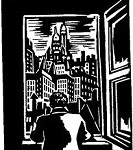This year’s EFC conference invites us to reflect on the various meanings of a city.
We currently have 50 percent of the world’s population living in cities, with the number of city-dwellers projected to double in 30 to 40 years. National governments focus on the health of cities because they’re powerful economic engines. Kent Martinussen of the Danish Architecture Center explains that beyond serving as the frameworks for our lives, cities spur creativity by encouraging face-to-face interaction; they act as centers of innovation that foster entrepreneurship. Their proximity to universities and production facilities transforms them into hubs of ‘collective value creation’.
To Jan Gehl, Danish architect and urban design consultant, great cities have a distinctly sensuous side. As we walk through well-designed urban spaces, we’re squeezed together, our conversations begin to overlap. We experience new colors and smells and sounds as we explore what Gehl calls ‘five kilometer per hour architecture’, a good habitat for homo sapiens living in an urban environment.
There’s a spiritual dimension to cities we often overlook when we’re focusing on their design and sustainability. Beyond the fact that urban centers produce 75 percent of the world’s greenhouse gases; beyond the problems created by the concentration of urban poverty in slums — cities invite us to imagine a different moral order. Here’s how the great 19th-century Scottish evangelist Henry Drummond described it in his essay, The City Without a Church:
[T]he Church with all its splendid equipment, the cloister with all its holy opportunity, are not the final instruments for fitting men for Heaven. The City, in many of its functions, is a greater Church than the Church. It is amid the whirr of its machinery and in the discipline of its life that the souls of men are really made. How great its opportunity is we are few of us aware. It is such slow work getting better, the daily round is so very common, our ideas of a heavenly life are so unreal and mystical that even when the highest Heaven lies all around us, when we might touch it, and dwell in it every day we live, we almost fail to see that it is there.
 I see this soul-building function of the city at work in the wood prints of Frans Masereel, in which a young hero opens his heart to the agonies and ecstasies of his urban environment. I’ve felt it in my own walks through various cities, where almost invariably I see that the collection of rubbish and other undesirable jobs is meted to an urban underclass. In the United States, ironically, members of this underclass find it increasingly difficult to afford living in the cities they so faithfully serve.
I see this soul-building function of the city at work in the wood prints of Frans Masereel, in which a young hero opens his heart to the agonies and ecstasies of his urban environment. I’ve felt it in my own walks through various cities, where almost invariably I see that the collection of rubbish and other undesirable jobs is meted to an urban underclass. In the United States, ironically, members of this underclass find it increasingly difficult to afford living in the cities they so faithfully serve.
A stroll by the newspaper stand invites reflection on what we as a species find important. We’re given the option to respond to or ignore a plea for help on almost every street corner. We can disappear into a crowd, putting some distance between us and our role as grantmaker or parent or member of the local school board, affording us the ability to approach the ‘daily round’ in a new way.
I don’t mean to suggest that every saunter through a city can or should be transformative. Sometimes we just want to buy eggs. And an urban center, with its glorious architecture and parks, can be a balm as well as a prod. But to paraphrase Nietzsche, I’ve appreciated the city best when it has most angrily contradicted me, when it has challenged me to consider the lives that others lead outside my tiny urban bubble.
Last night I saw the power of a great city on display in Copenhagen’s Vesterbro neighborhood where thousands of people took to the streets as part of the annual Distortion festival. What impressed me most was not the music or the glorious weather or the piles of beer cans, but the constant chatter. When the chattering happened in a language I could understand, I heard celebration, delectation, deliberation: nine young people at a picnic table with one candle between them, arguing about something a sociology professor had said; two couples sitting under the stark light of a streetlamp, all of them fully clothed but still very much in the manner of Le déjeuner sur l’herbe, recommending movies to one another; several Danes pushing a shopping cart, with one leading a spirited call and answer. Making my way through the train station, I felt as if the patients of Bedlam’s wards had been emptied onto the platforms.
I felt very much alive. Today I feel restless. Did I witness last night a foretaste of the end of the world? or was it the means by which the world would be transformed? This to me is perhaps the greatest virtue of the ‘sustainable cities’ around which we’ve organized our discussions at this conference: they have the power to keep repeating the questions even when we feel we’ve supplied all the answers.
Albert Ruesga is President & CEO of the Greater New Orleans Foundation and founding editor of the White Courtesy Telephone blog



Comments (2)